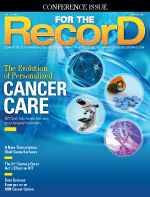March  2017
2017
Chart Conundrums: Technically Correct But Totally Useless
By Jon Elion, MD, FACC
For The Record
Vol. 29 No. 3 P. 26
A man is flying in a hot air balloon and realizes he is lost. He reduces height and spots a man down below. He lowers the balloon further and shouts, "Excuse me. Can you help me? I'm lost."
The man below says, "Yes, you are in a hot air balloon hovering approximately 40 feet above this field."
"You must be an expert at using an electronic medical record," says the balloonist.
"I am," replies the man. "How did you know?"
"Well," says the balloonist, "everything you have told me is technically correct but totally useless."
I often think of this story when reading clinical notes in an EMR. The facts may be there, but without a proper framework, reference point, or context, the information may be difficult to use or interpret.
Recently, I was reviewing the chart of a patient who had developed complications from an infection. The admitting note described the initial infection as a discrete lesion that was associated with signs of inflammation (localized heat, redness, and swelling). The physical examination description included a normal blood pressure, had no further description of the patient's appearance or overall skin appearance, and did not document the patient's mental status. The laboratory data showed an elevated white blood cell count and an elevated serum lactate.
At this point, my internal alarm bells started to go off; something did not add up. An elevated serum lactate indicates that cells are not getting enough oxygen. Monitoring the levels of serum lactate may be helpful in diagnosing and treating conditions such as shock and trauma, but nothing in the chart's notes indicated there was concern about either condition. What was it about the patient's presenting picture that led the clinician to order that blood test?
My guess is that the patient may already have been showing signs of shock. Blood pressures can sometimes be misleading and normal, even when blood flow to vital organs is starting to shut down. Some of the associated findings (more reliable than blood pressure alone) included a decrease in urine output (not yet apparent when the patient is first seen), altered mentation, and cool and clammy skin.
No Place for Guesswork
But the big lesson here is: Don't make me guess. If the admitting note had provided a more complete picture of the presenting findings, I would have had a clear context to interpret the blood test and the reasoning behind ordering it.
The following are a few simple tips to help create notes that tell a more comprehensive story:
• Characterized by: Use the phrase "characterized by" to justify your selected terms. For example, "The patient has claudication, characterized by pain in the calves when walking one block, and relieved at rest."
• Interpretation first, then supporting data: An extension of "characterized by," this approach helps immensely in presenting a clear and concise story. For example, rather than rattling off numerical values, say, "The blood gases are consistent with a metabolic acidosis with partial respiratory compensation, with a pH of ..." then fill in the data. Provide the framework and then add the details.
• Use pertinent negatives: This is one of the major challenges for medical students to learn as they move from simple recitation of facts to beginning to synthesize and collate information into a meaningful clinical presentation. "This 28-year-old woman presents with sudden onset of pleuritic chest characterized by poorly localized chest pain made worse by deep inspiration. She is not on birth control pills, has not had recent extended sitting during travel or otherwise, and does not have painful or swollen legs." Simple recitation would put some of these negative facts elsewhere in the write-up of the patient's history. It makes more sense and tells a better story to put them together with the description of the presenting problem.
• Explain your plans: Don't assume your plans are self-explanatory. Briefly note why you are ordering a test or beginning a treatment. This may also prompt you to go back and fill in the missing pieces of your story if you have not created a sufficient justification for your action. In the case of my patient with the infection, the physician who first saw her should have listed in the plans something akin to, "Check serum lactate to evaluate possible shock/tissue hypoperfusion." They might then see that they did not yet describe anything to explain this concern, and would have a chance to edit the physician exam note to include skin that was cold and clammy.
• Show your thinking: My longest notes are those that describe why I am not doing something. I need to show that I have evaluated the situation and alternative approaches and understood the presenting pathophysiology but chosen not to treat, rather than simply having overlooked things. "The monitor shows short bursts of an idioventricular rhythm eight hours after angioplasty of a totally occluded circumflex coronary artery. This is consistent with a reperfusion arrhythmia—will observe and withhold antiarrhythmic therapy, as this is typically benign and self-limited." You can agree or disagree with my interpretation and plan, but you don't have to guess what I was thinking or whether I even recognized the problem.
The pull-down menus and "smart notes," or templates, pervasive in today's EMR world can contribute significantly to the creation of a clinical note that is factually correct but not very helpful. Don't let those tools get in the way of your ability to paint a complete picture and tell a meaningful story. You'll practice better medicine, for which your colleagues will be most grateful.
— Jon Elion, MD, FACC, is the founder of ChartWise Medical Systems, Inc, a Rhode Island–based company.



